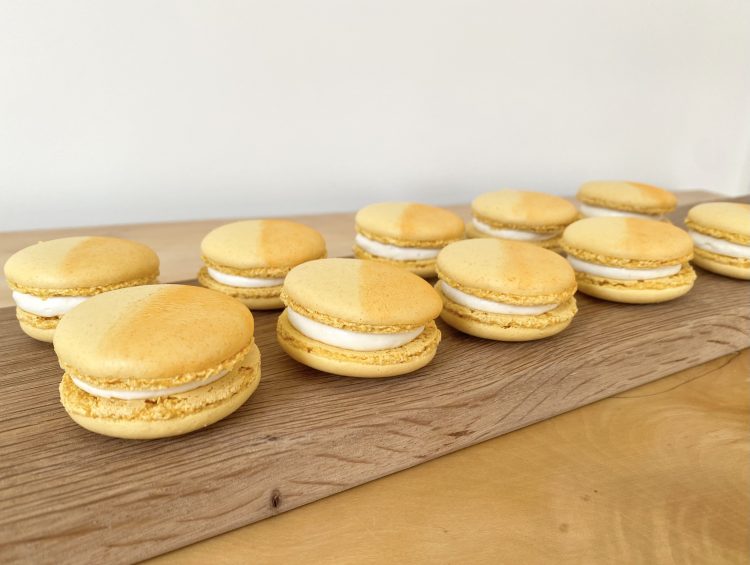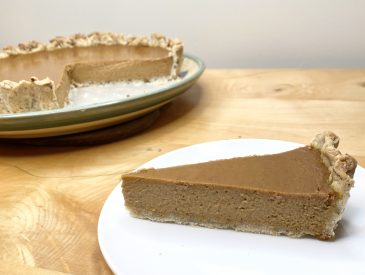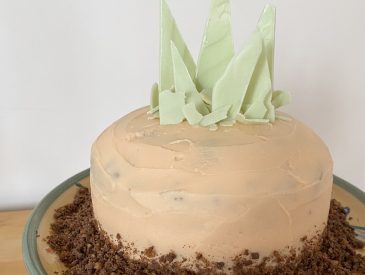Ladurée (the iconic macaron brand!), released an official Roland-Garros macaron this year, as part of their ongoing partnership with the tennis event. Obviously this collaboration was right up my alley, because there are very few things that I love more than macarons and tennis (and Bridgerton, but that’s not relevant here). A combination of the two? Sign. Me. Up.
The Roland-Garros macaron is a lime & galangal-flavoured macaron (which is kind of wacky, so I was EXTRA intrigued). The shells are tinted a deep yellow shade and decorated with an orange Roland-Garros logo (which I assume is printed onto the shells using an edible printer?). Unfortunately, I don’t think you can buy this particular macaron in the UK, so, of course, I decided to make my own version.
There’s not a whole lot of information out there on the exact composition of the macarons, so I just took the flavour combination (and a lot of creative licence) and ran with it! This recipe, therefore, is my personal take on lime & galangal macarons, inspired by the official Roland-Garros 2024 macaron by Ladurée.
Table of Contents
- Lime & Galangal Macarons: The Breakdown
- Ingredients
- Making the Yellow Macaron Shells
- Making the Lime & Galangal Filling
- Assembling the Macarons
- Lime & Galangal Macaron Recipe
Lime & Galangal Macarons: The Breakdown
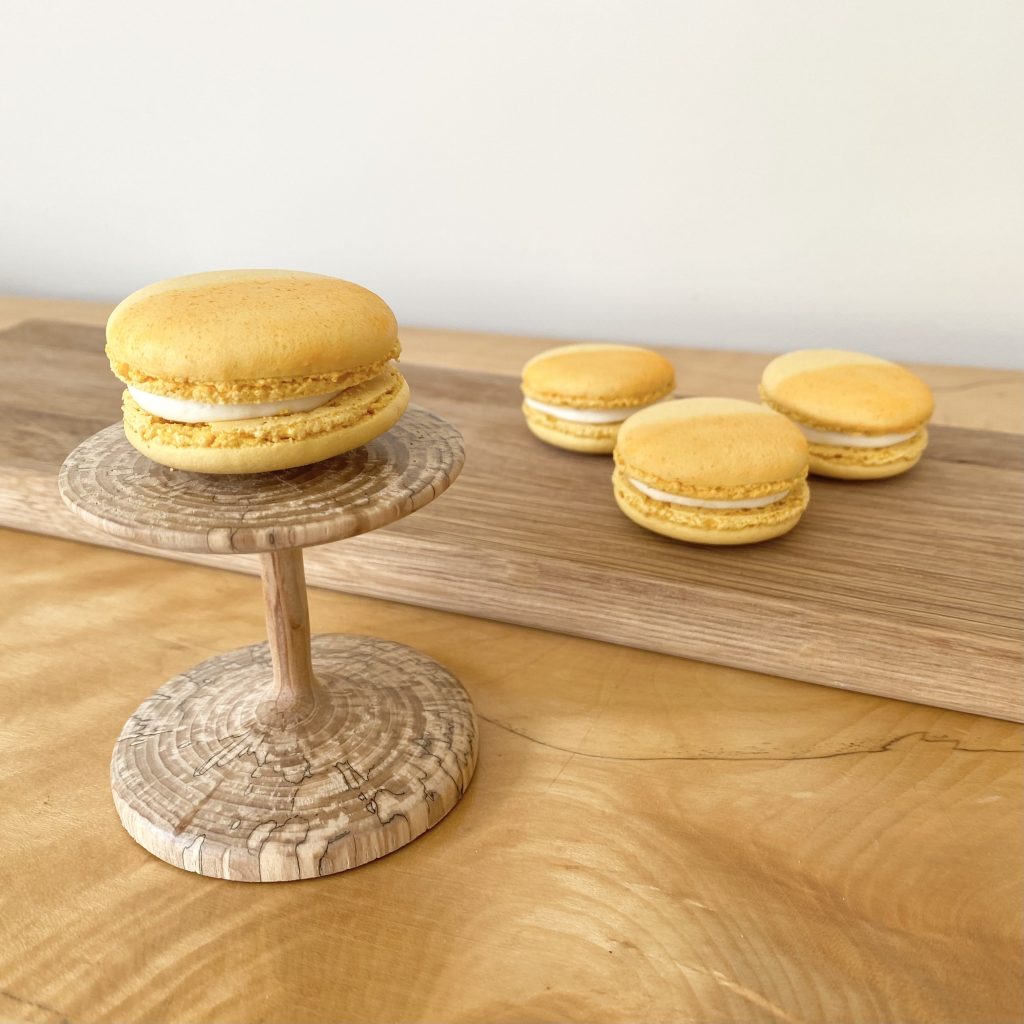
My lime & galangal macarons are made with my classic macaron shells, which I have tinted a deep yellow colour, using a combination of yellow and orange water-based food colouring. All of the lime & galangal flavour comes from the filling: a lime & galangal curd that is lightened with whipped cream. As a nod to the design of the original macarons, I’ve dusted my shells with orange food colouring dust, giving them this pretty, orange sherbet, half-and-half look.
Ingredients
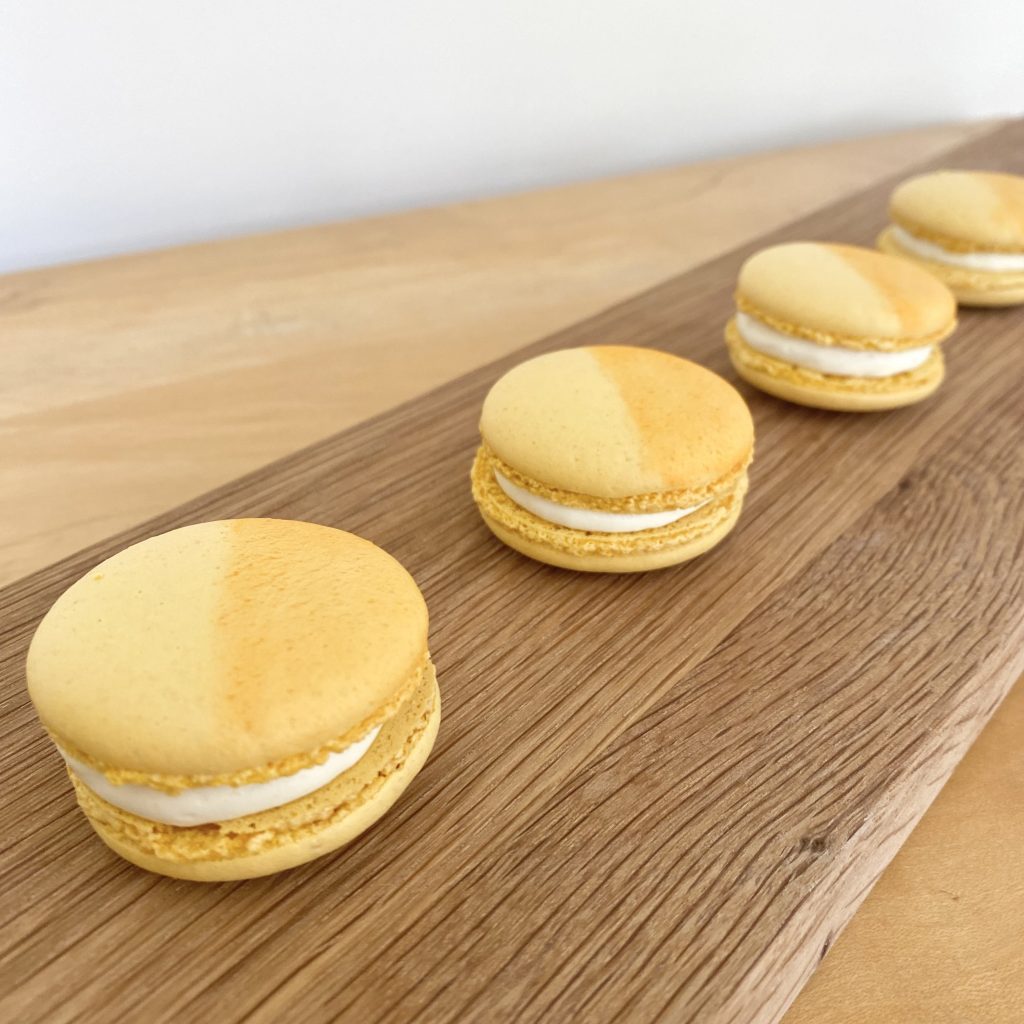
To make the macaron shells, you will need the following ingredients:
- Ground almonds: This gives the macarons their iconic, nutty taste and texture. The almonds need to be very finely ground, so don’t skimp on the sieving/blitzing steps.
- Icing sugar: One of the two types of sugar in the shells, the icing sugar is mixed into a paste with the almonds and half of the egg whites.
- Egg whites: You don’t need the yolks for this recipe, so set them aside for a different recipe. It’s vital that you weigh your egg whites for this recipe, because macarons are very particular about ratios and quantities!
- Caster sugar: The second type of sugar. This is heated with the water to form a sugar syrup, which is used to make the Italian meringue.
- Water: This is mixed with the caster sugar to make the sugar syrup.
- Yellow & orange food colouring: it’s very important that you use the right food colouring when making macarons- your food colouring needs to be a water-based, gel food colouring. For these macarons, I used the Colour Mill Aqua Blend Food Colouring, in the shades Yellow and Orange.
- Orange Edible Dusting Colour: This is optional, but I used this edible dust to decorate my shells, as a nod to the orange logo on the original Ladurée macarons.
To make the lime & galangal filling, you will need:
- Egg: You need the whole egg (yolk and white) for the curd.
- Caster sugar: This adds sweetness to the curd.
- Limes: You will need the finely-grated zest, as well as the juice, of the limes, to get a really intense, bright flavour.
- Galangal paste: A slightly rogue ingredient for a citrus curd, but if it’s good enough for Ladurée, it’s good enough for me. Galangal is a root that is used frequently in South Asian cooking- it’s often compared to ginger, but it has a more floral, slightly medicinal flavour. By adding it to the lime curd, you not only introduce some of those subtle, floral notes, you also add a little warmth to the curd, which hits you at the end of each mouthful. In the UK, galangal is most readily available in paste form, so that’s what I’ve used for this recipe.
- Unsalted butter: Butter makes the curd rich and smooth.
- Double cream: We will fold the curd into whipped cream, for a lighter, creamier mouthfeel and a structure that is more suited to holding two macaron shells together.
Making the Yellow Macaron Shells
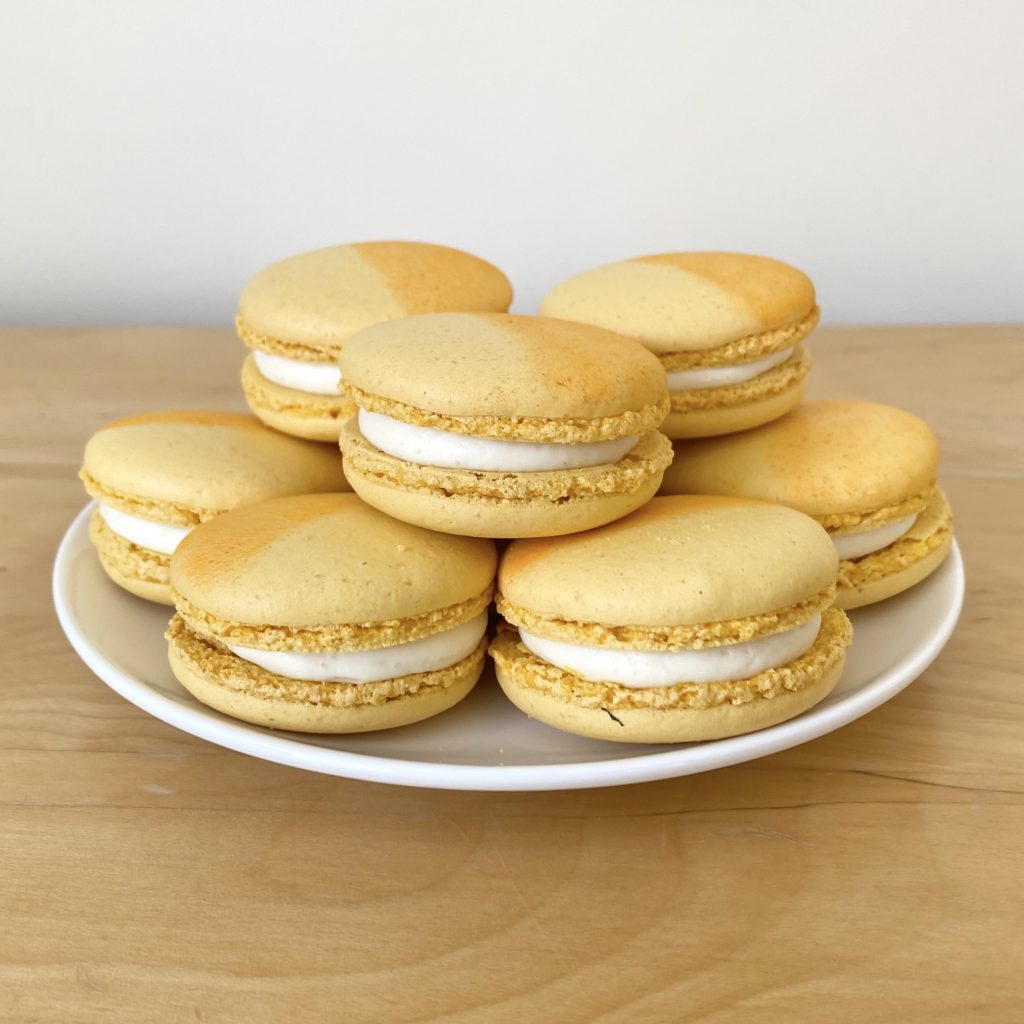
I have done a lot of posts on how to make macaron shells here on the blog, so I won’t be doing a deep dive into that here. If you want a complete walkthrough of the process, you can find my master macaron post here.
I will, however, talk about how I achieved this gorgeous shade of yellow, because I’ve never actually made yellow macarons before, so this was learning curve for me!
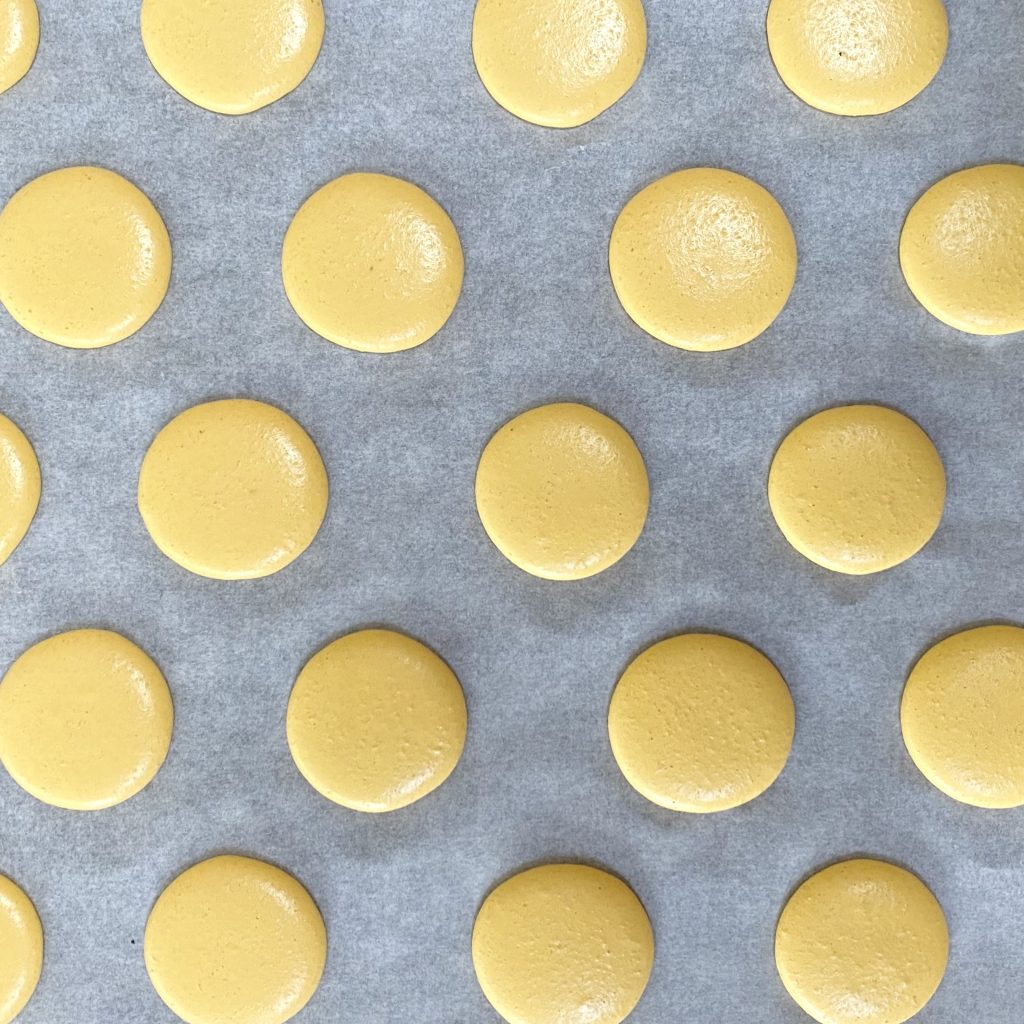
Admittedly, the original, Ladurée macaron shells are a much stronger shade of yellow compared to my shells. Despite the impression my recipes might give, I don’t actually love using loads of food colouring in my bakes, so I decided to aim for a slightly softer shade of yellow for my macarons. I also prefer not to use too much food colouring when making macarons, in particular, because they are so finicky- adding too much of anything outside of the core ingredients can cause major macaron issues.
Anyway, as always with colouring macaron shells, I followed a few key principles:
- Use a water-based, gel food colouring: This is the most important thing- oil is the enemy of the macaron, so you absolutely cannot use an oil-based food colouring to tint macaron shells. It’s water-based all the way, baby. Furthermore, it’s important to use a gel food colouring, not a liquid one, as you’ll get more colour payoff with less colouring, meaning your batter/bake is less likely to be affected. I swear by Colour Mill’s Aqua Blend Food Colouring range for my macarons- for these ones, I used a combination of the shades Yellow and Orange.

- Go darker than you think: I like to add the food colouring to the initial almond + icing sugar + egg white paste, to ensure that it is fully incorporated before the macaronage stage. However, when you do this, it’s important to remember that the super-white meringue will drastically lighten the colour. Aim to get the right tone of your desired colour, in a much deeper shade, so that when the mixture lightens, it lightens down to the perfect colour! Sometimes, you can do this by using a dark food colouring in the first place, like I did with my Earl Grey Macarons. For a shade like yellow though, it’s a little trickier. In the end, I used mostly yellow food colouring, for the right tone, then darkened it up with a little orange colouring, which gave me this deep, almost egg yolk shade, which lightened to a pretty, almost banana-yellow!
- Keep an eye on the shells when they’re baking: Over-baking macarons can lead to the surfaces browning, because the sugar in the shells start to caramelise. You need to be particularly careful of this when baking coloured macaron shells, because any amount of browning will affect the colour of the macarons.
Making the Lime & Galangal Filling
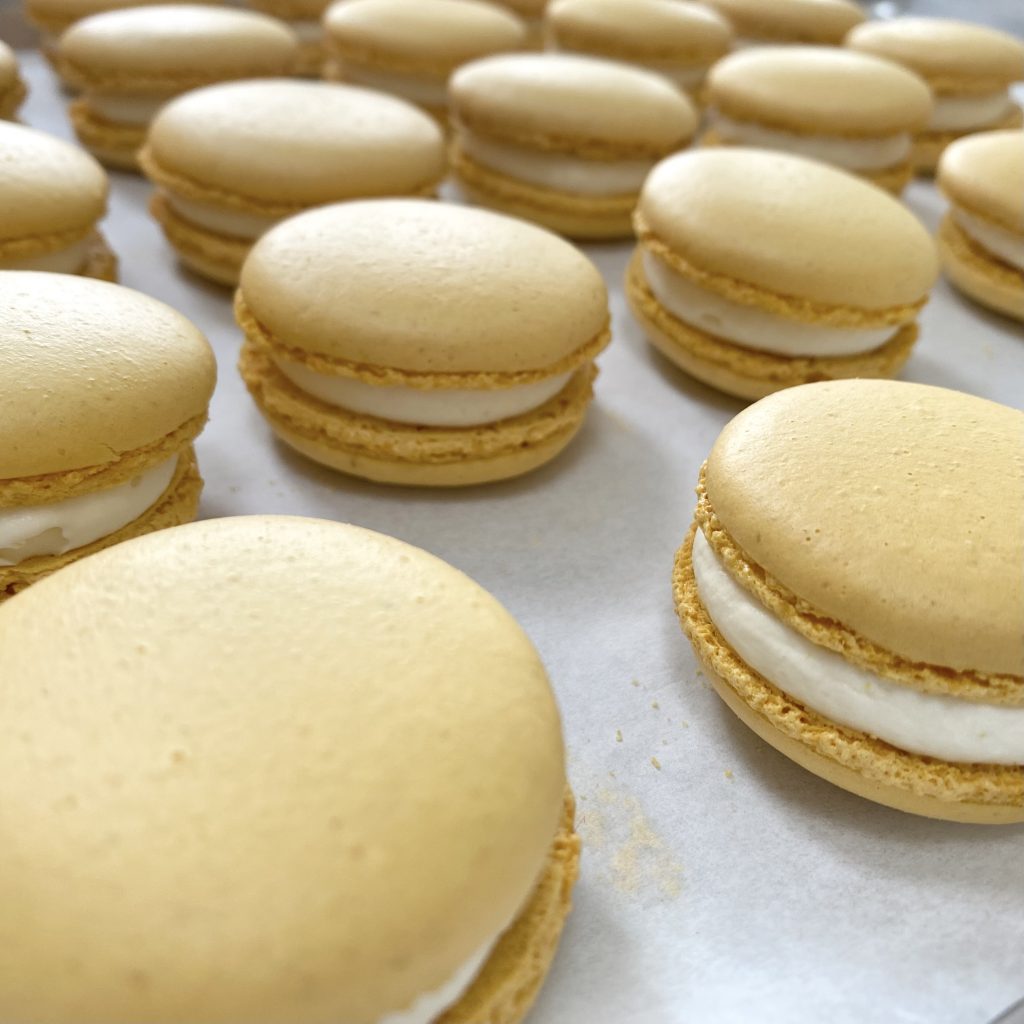
Now we come to the fun bit: the lime & galangal filling! As I mentioned, this is just a lime & galangal curd, which is folded into whipped cream to make a silky-smooth, airy and fresh filling. You’ll need to make the curd ahead of time (at least an hour), so that it has plenty of time to chill and firm up in the fridge, but, on the bright side, it’s super quick and easy to make! You’ll only need half of the batch of curd for this recipe, but you can use the rest for all sorts of things (for example: as a snack on toast!), so it won’t go to waste.
I prefer to make curd in a saucepan, directly over the heat (as opposed to in a bain-marie), because I find it much quicker (it only takes about 5 minutes!) and easier. You just need to make sure you stir the mixture constantly, to prevent it from catching, and that you pass the finished curd through a sieve to remove any bits of egg (which I would do anyway, even if I made the curd in a bain-marie, so it all works out).

Start by putting the beaten egg, sugar, galangal paste (that’s the slightly… shrimpy looking? pink stuff on the left), lime zest and juice into a small saucepan.
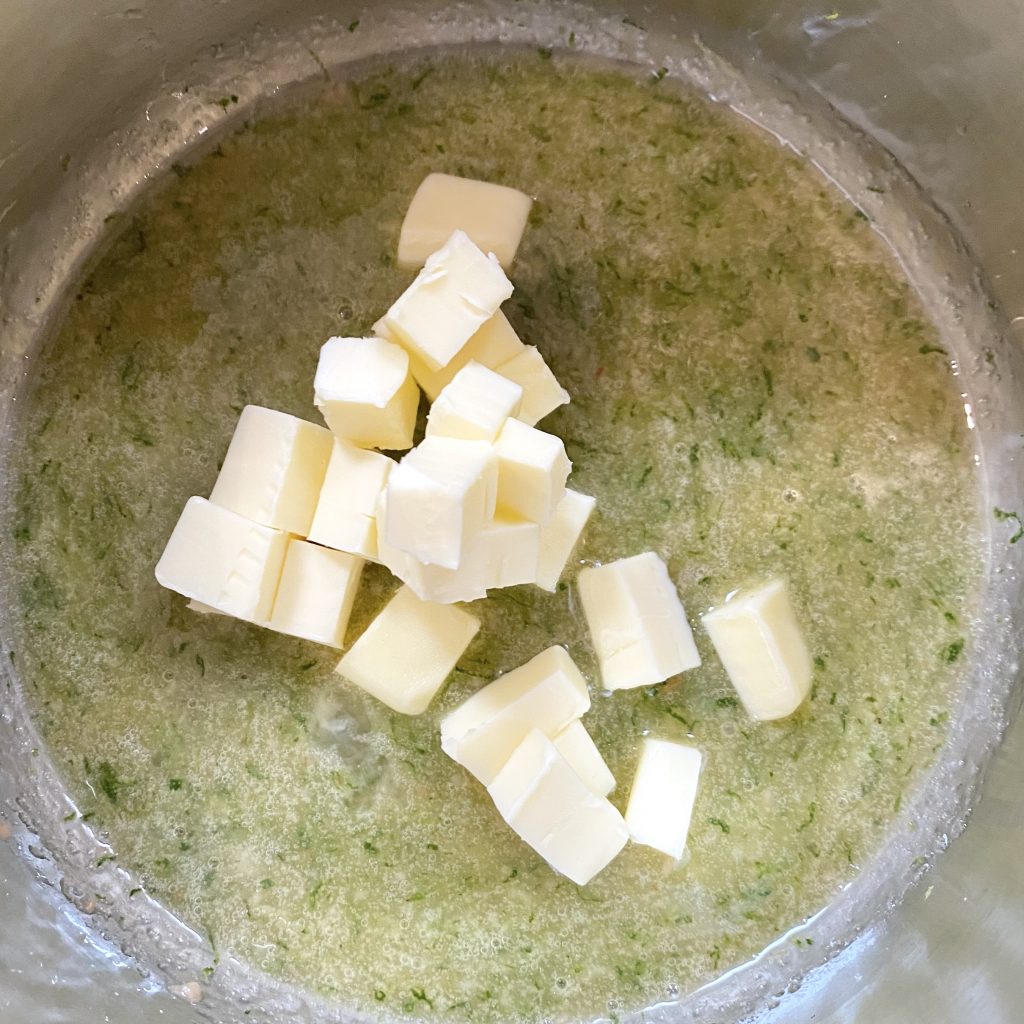
Mix everything together well with a fork or whisk, so that the galangal and lime zest is evenly distributed throughout the mixture and the egg is completely incorporated. Then, add the diced butter and put the pan over a medium-low heat.
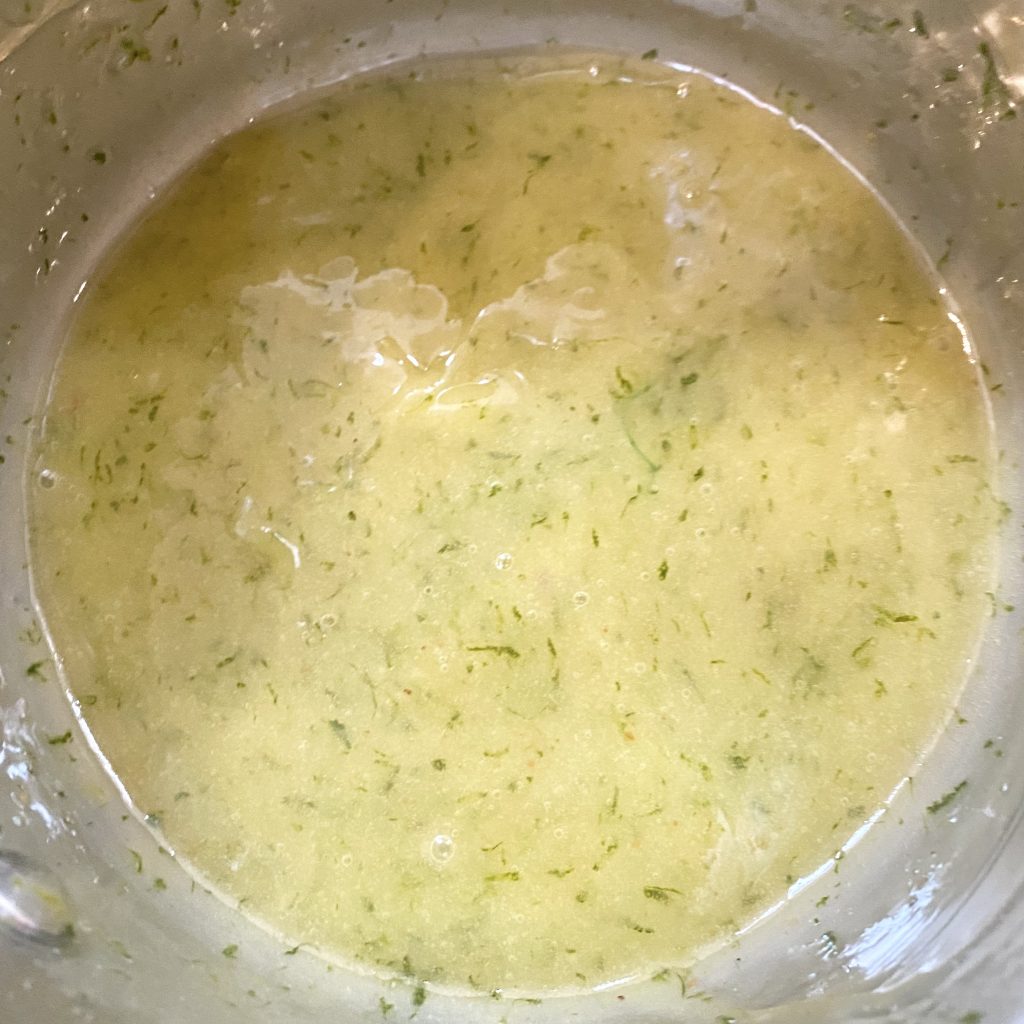
Stir constantly while the butter melts, then keep the pan over the heat, still stirring constantly, until the curd thickens. It should coat the back of a spoon when it is ready.

Pass the curd through a sieve to remove the zest, any large pieces of galangal and any little pieces of egg. This will leave you with a silky-smooth, lime & galangal curd.
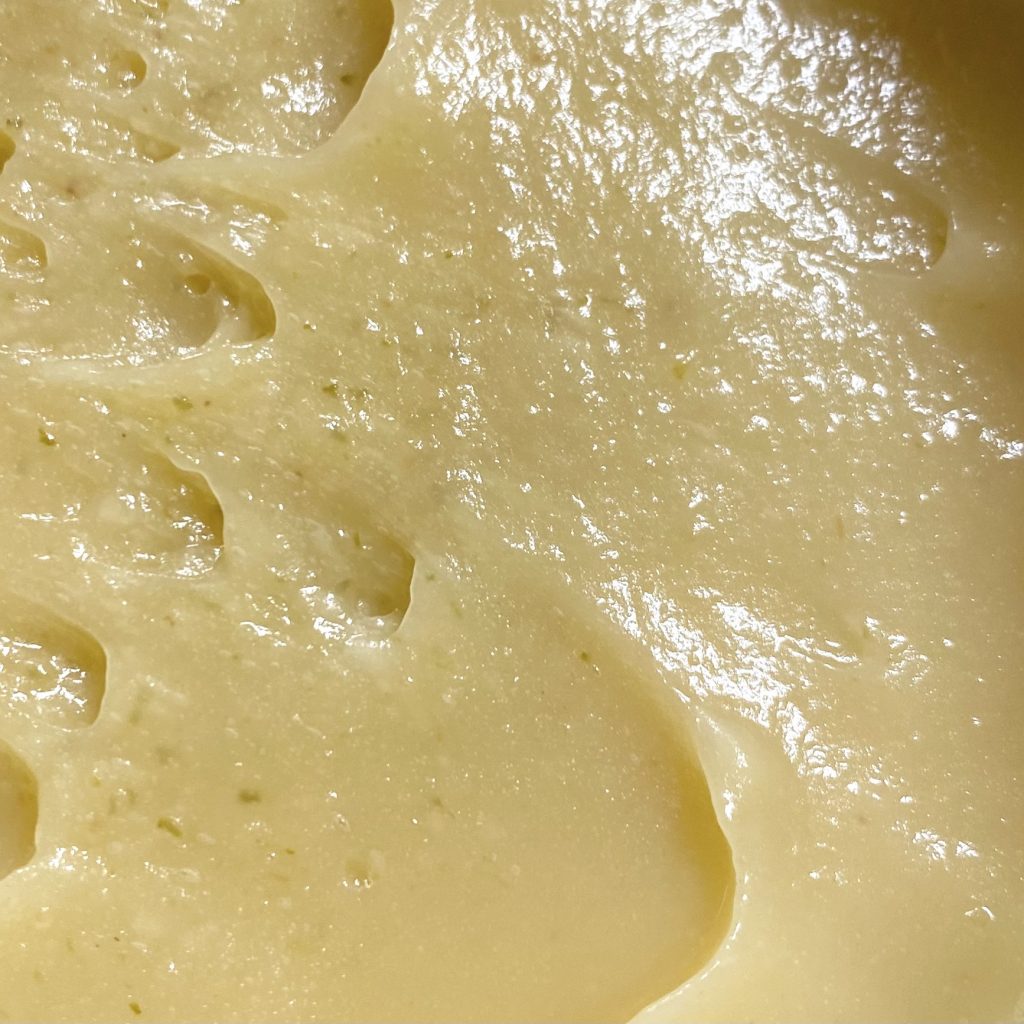
Cover the surface of the curd directly with clingfilm, then place into the fridge to chill and firm up, for at least an hour, or up to 4-5 days in advance. The curd will become paler in colour and more opaque as it chills.
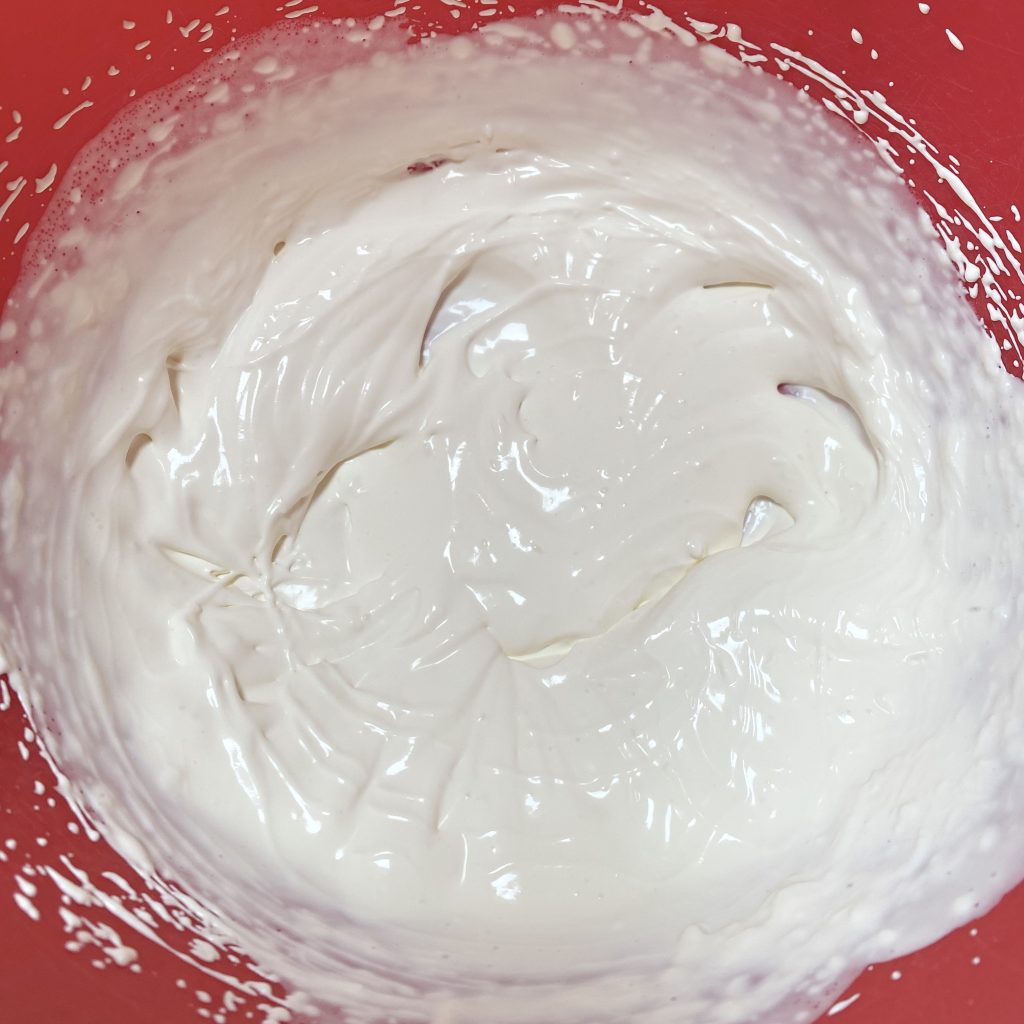
Once the curd is chilled and you are ready to assemble your macarons, you can finish the filling. In a large bowl, whip the cream until it reaches just below stiff peaks. I could have taken mine a little further at this stage, but I was being cautious!
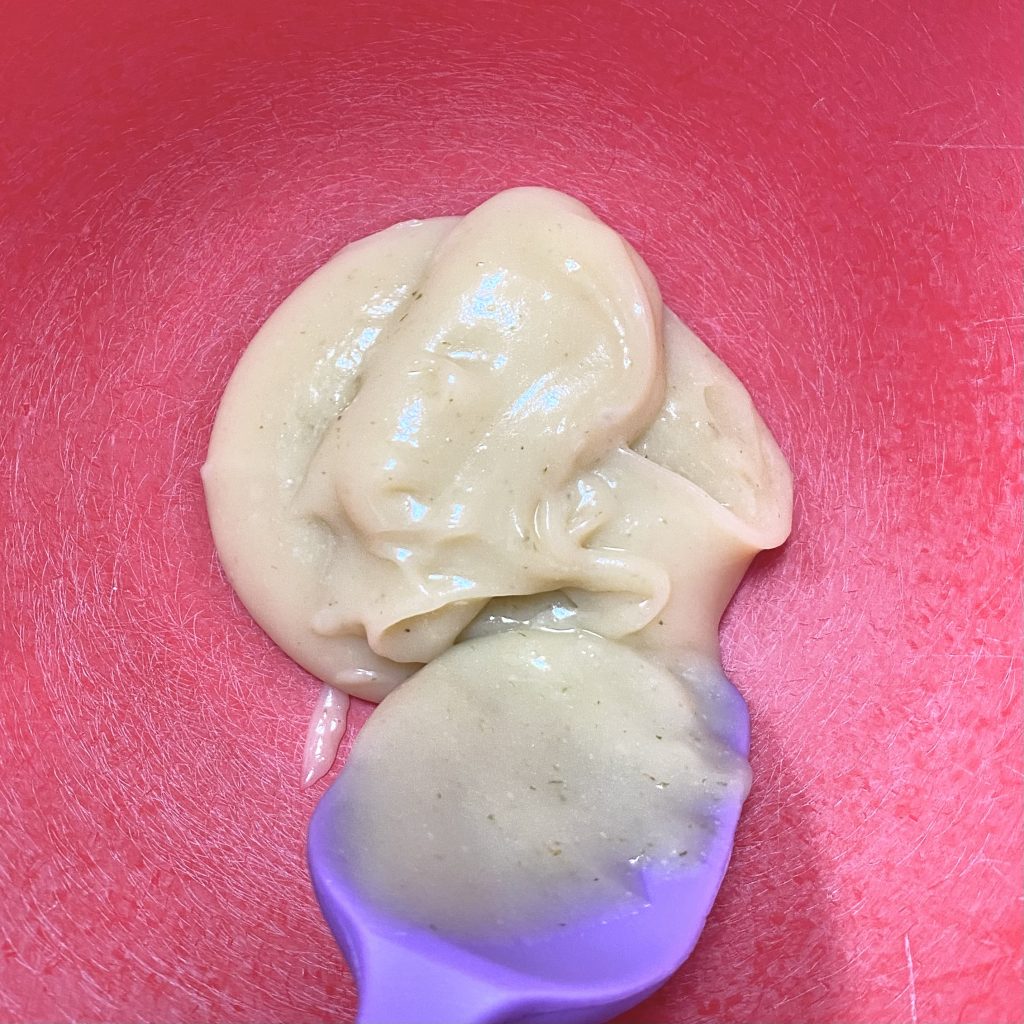
Transfer half of your chilled curd to a small bowl.
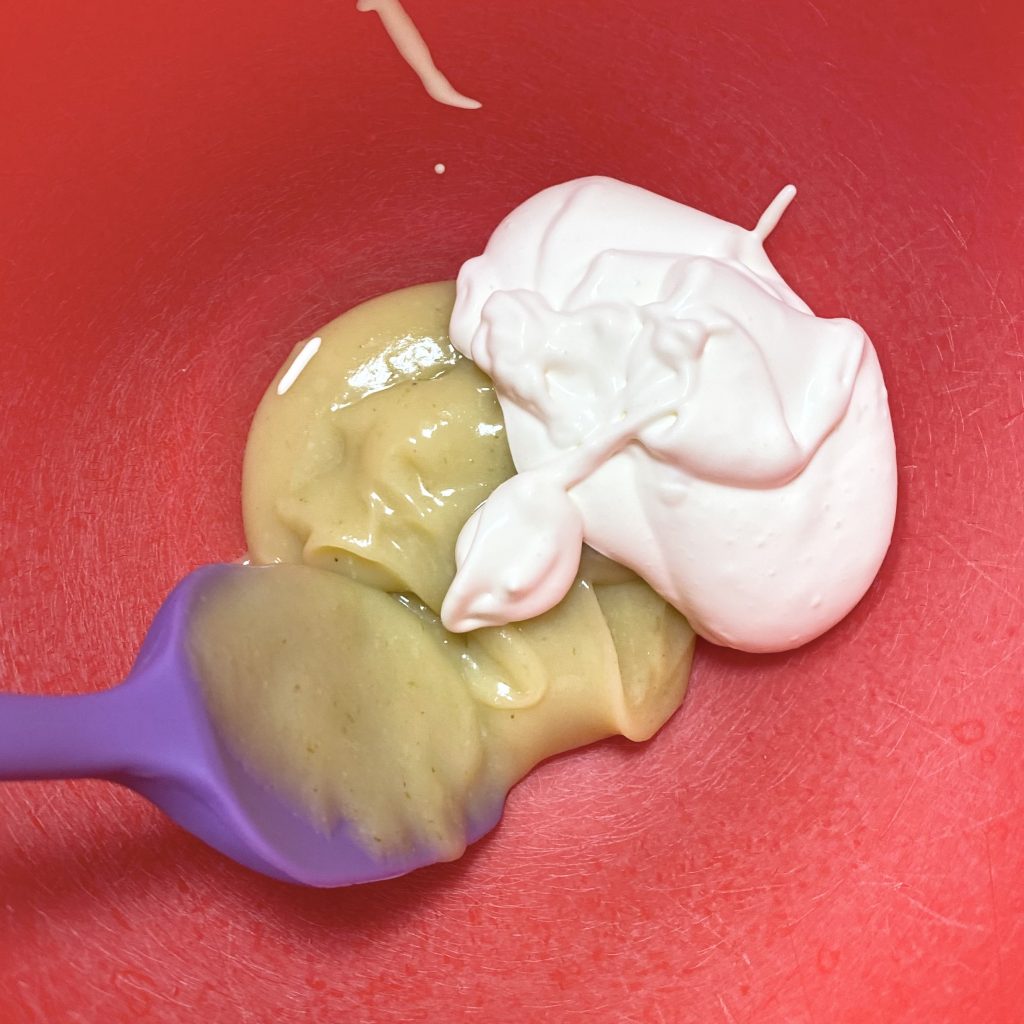
Add a spoonful of cream to the curd. We’ll start by vigorously mixing in a small amount of cream, which will lighten the curd and make it easier to fold into the rest of the cream.
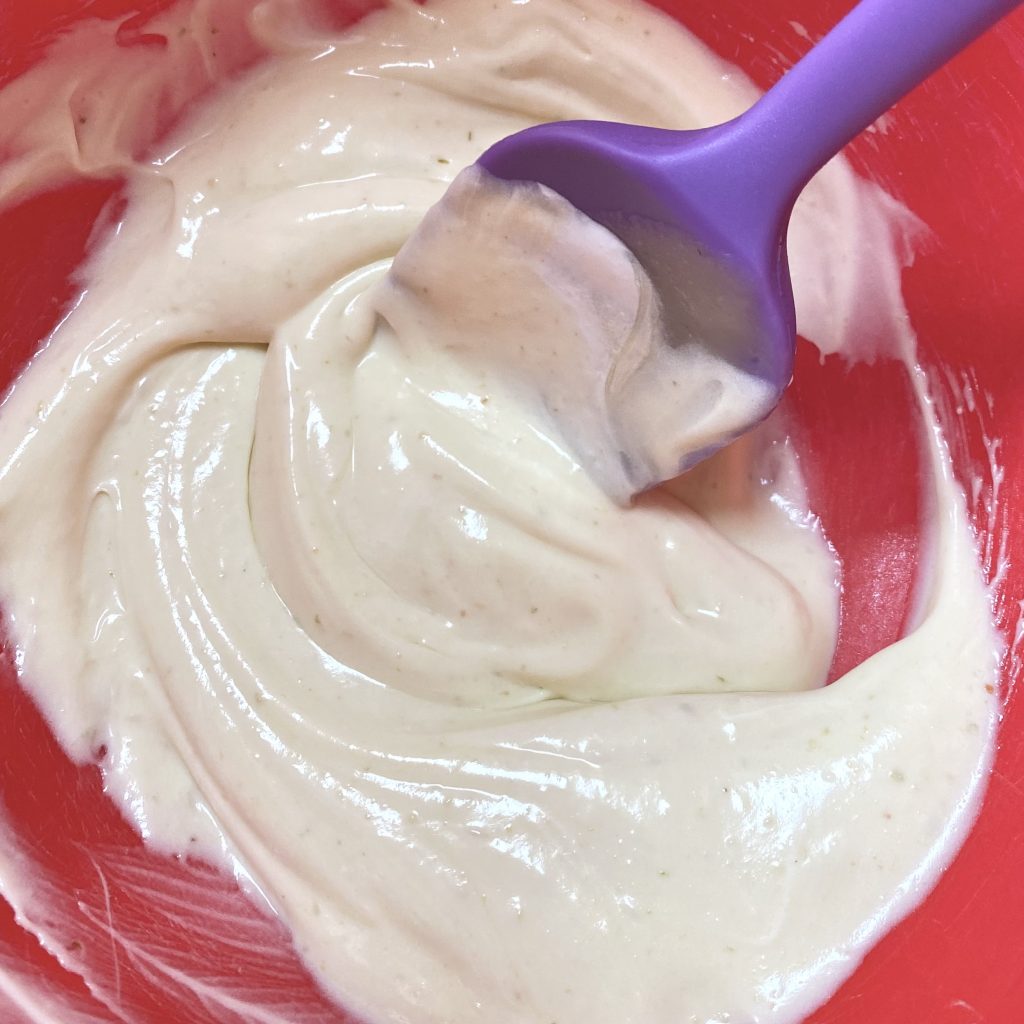
Mix together until everything is completely incorporated.
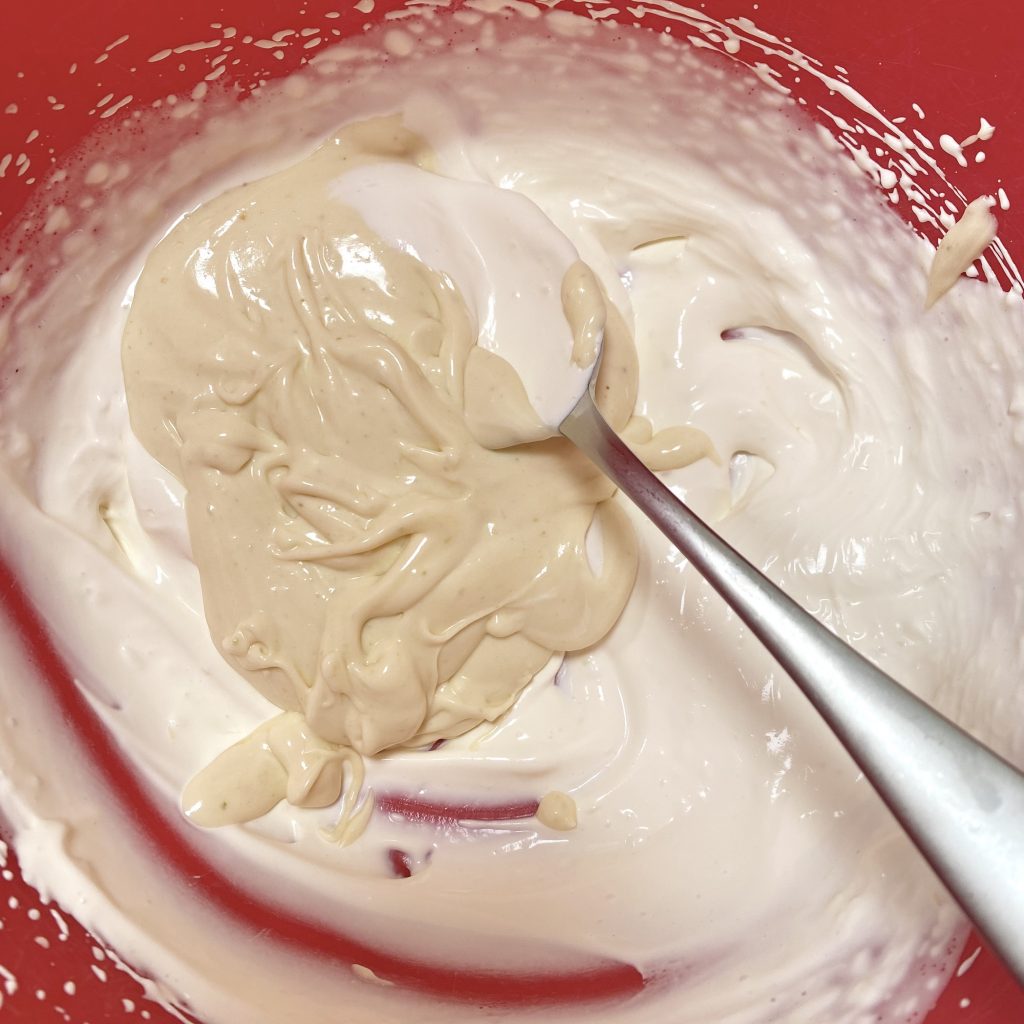
Then, fold through the remaining whipped cream, until smooth and evenly combined.
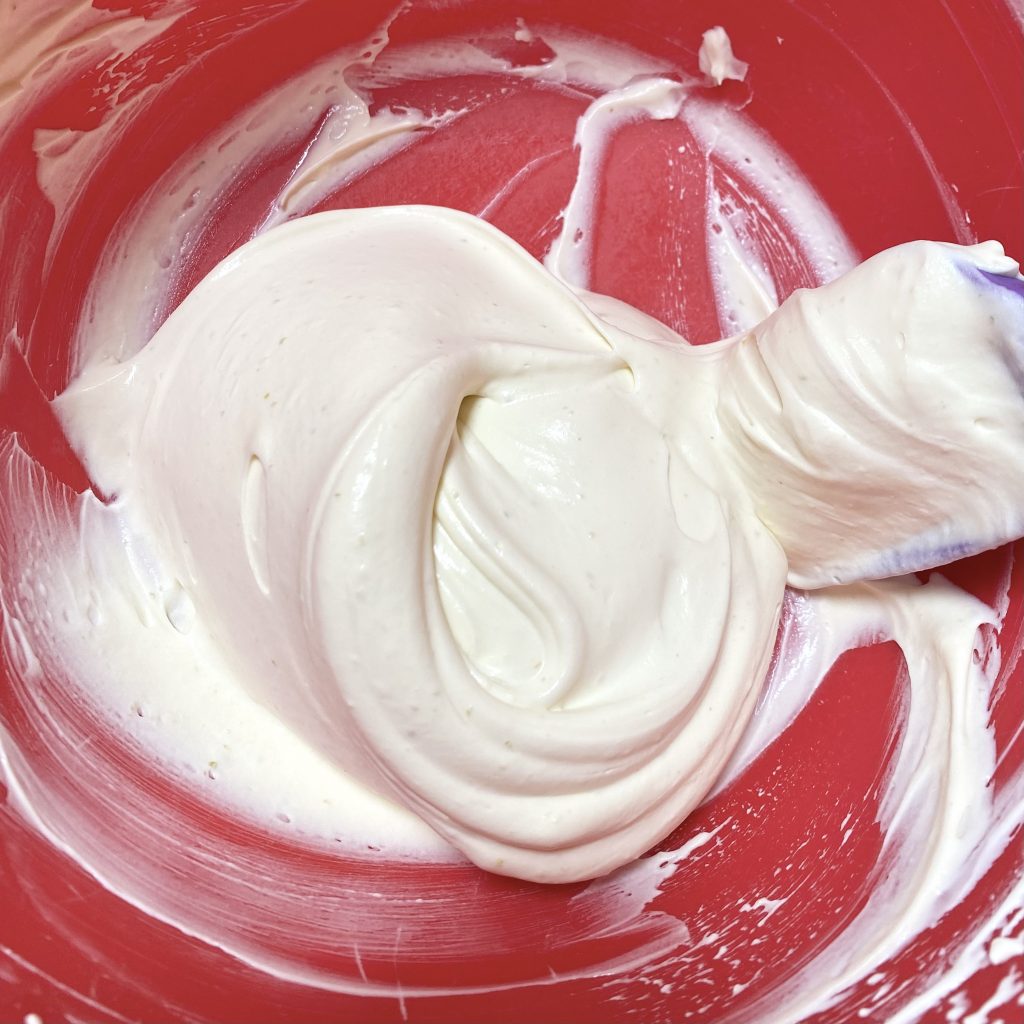
If your filling is a little on the soft side (like mine was…), you can always keep whipping it with the electric whisk. Does this undermine the whole folding process? Probably. Does it make that much of a difference? Absolutely not. Ideally, you want a firm, pipeable consistency, that won’t ooze out of your macarons too much, like this…
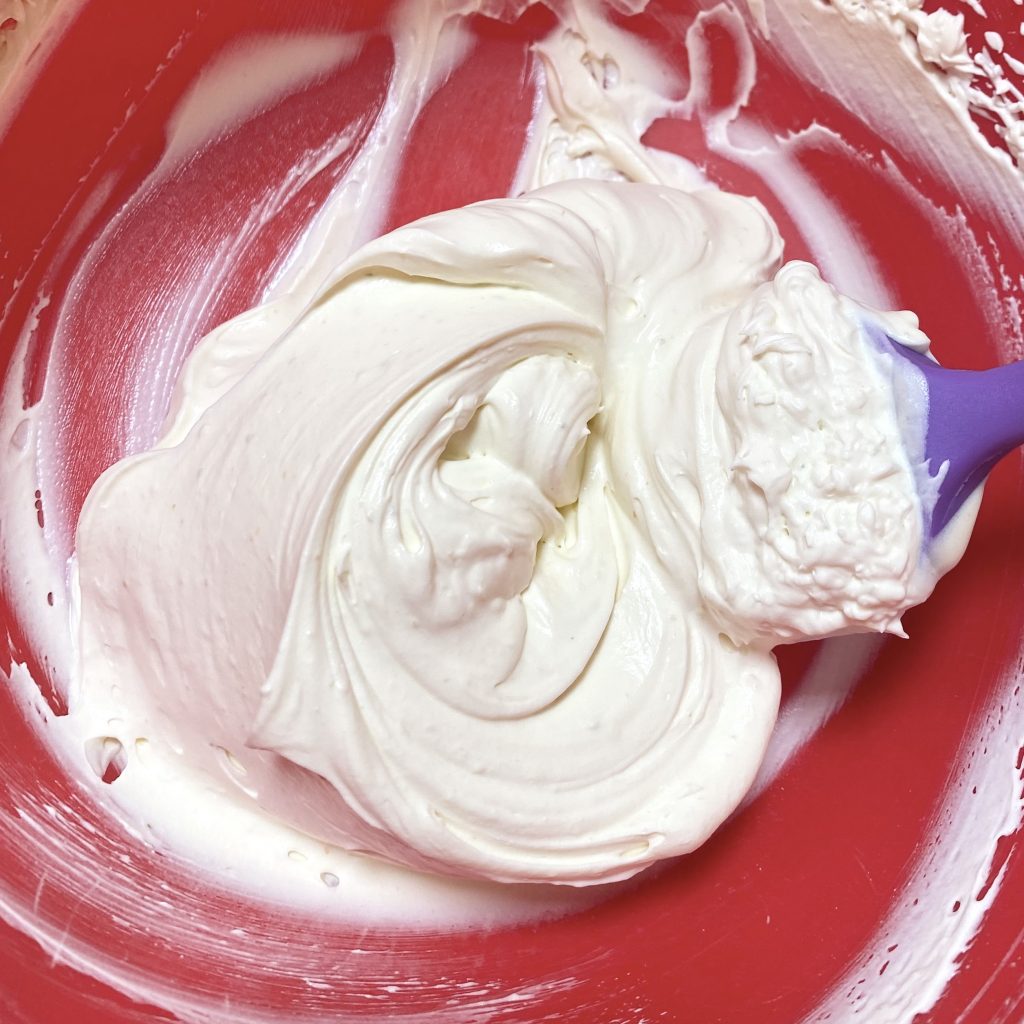
And there you have it- a zesty, fresh and light lime & galangal filling, ready for your macaron shells.
Assembling the Macarons
To assemble the macarons, all you need to do is sandwich two shells together with a small amount of the lime & galangal filling.

You can use a teaspoon, blunt knife or piping bag to place the filling onto the underside of one shell, before gently pressing the other half on top.
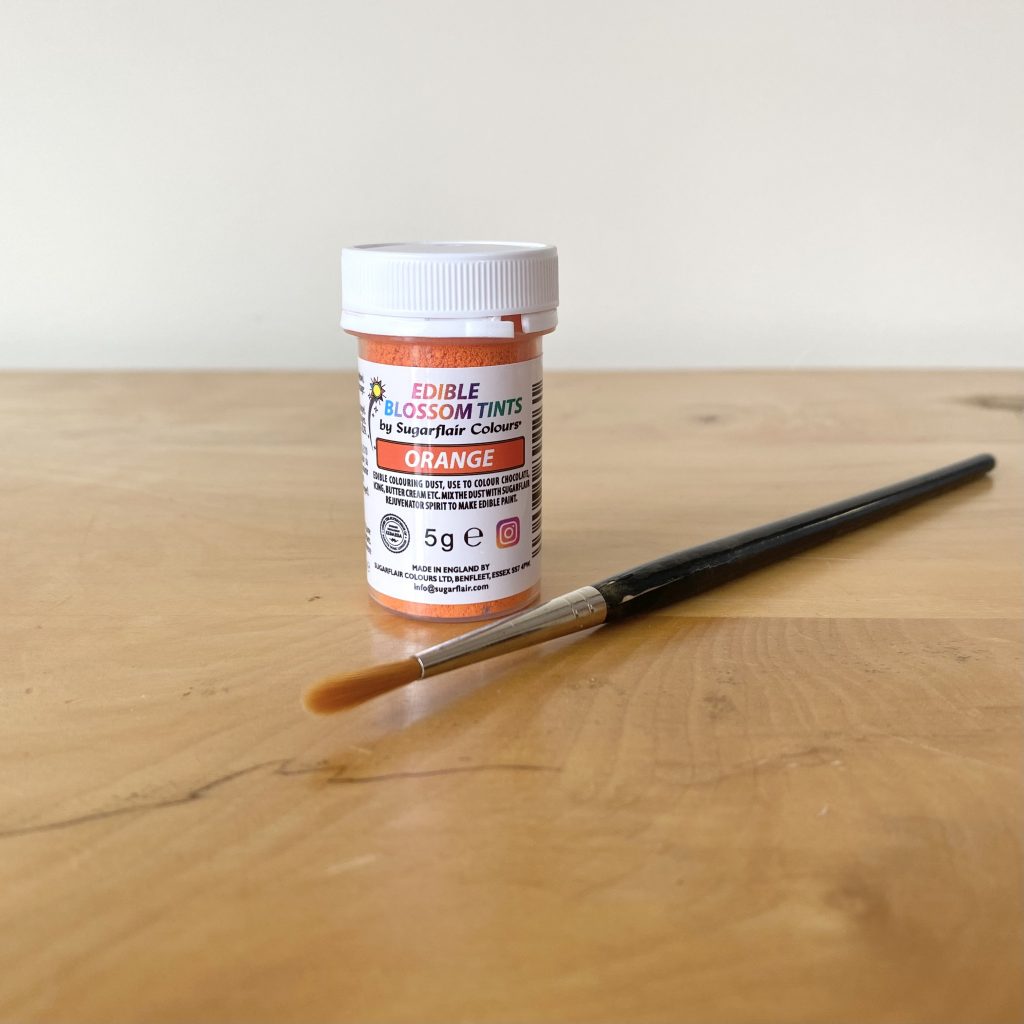
If you want to decorate your macaron shells like mine, use a small, dry paintbrush to add a small amount of orange food colouring dust to the top of each macaron. I dusted one side of each shell, to give this half-and-half effect. You can either do this once you’ve assembled the macarons, or, if you want to get this stage done in advance, you can decorate the individual shells before filling them.
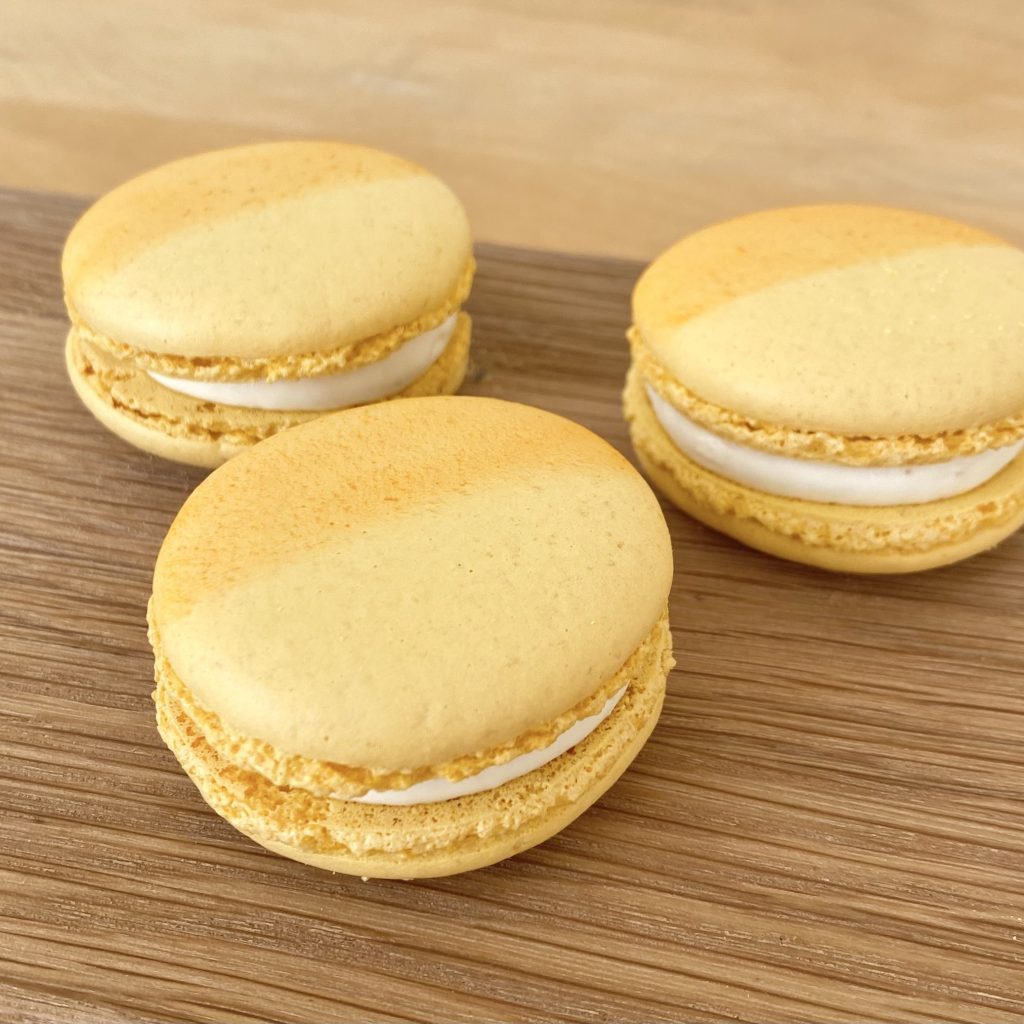
Because the filling of these macarons contains whipped cream, it’s best to eat them as soon as possible after assembling. They will, however, keep in the fridge for a day or two, if necessary (as long as the cream is within its original use by date!).
Lime & Galangal Macaron Recipe
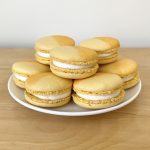
Lime & Galangal Macarons
Equipment
- 1 small(ish), round piping nozzle
- 1 piping bag
Ingredients
For the whipped lime & galangal curd filling:
- 1 egg, beaten.
- 75 g caster sugar
- 1 1/2 tsp galangal paste (see Note 1).
- 2 limes, zest and juice.
- 55 g unsalted butter, diced.
- 150 ml double cream
For the macaron shells:
- 95 g ground almonds
- 103 g icing sugar
- 72 g egg whites, split into two equal portions (2x36g).
- 95 g caster sugar
- 30 ml water
- Yellow & orange water-based gel food colouring (see Note 2).
To decorate:
- Orange edible colour dust (optional).
Instructions
Make the lime & galangal curd:
- In a small saucepan, mix together the beaten egg, caster sugar, galangal paste, lime zest and juice until completely combined.
- Add the diced butter, then place the pan over medium-low heat and stir constantly while the butter melts.
- Once the butter has melted, keep the pan over the heat and continue stirring until the curd has thickened. It should coat the back of a wooden spoon when ready.
- Pass the curd through a heatproof sieve to remove the zest/galangal, as well as any pieces of egg. Cover the surface directly with clingfilm, then place into the fridge to chill and firm up for at least an hour before finishing the filling.
Make the yellow macaron shells:
- Line 2 baking trays with baking paper. Fit a piping bag with a small(ish), round nozzle (mine was 6mm in diameter) and set aside.
- Place the ground almonds and icing sugar into a food processor. Pulse 10 times, then sift into a large bowl, discarding any large lumps. Repeat this process once more, so that you are left with a very fine powder.
- Add one of the 36g portions of egg white to the almond/icing sugar mixture, along with the food colouring (I used mainly yellow, with a few drops of orange to darken it). Mix well to form a paste with an even, deep, egg yolk shade, then set aside.
- Place the remaining 36g of egg white into the clean (see Note 3), metal bowl of a stand mixer, fitted with the whisk attachment. Leave aside while you make the sugar syrup.
- Place the caster sugar into a small saucepan with the 30ml of water. Place over a medium heat and bring to a boil. Do not stir- swirl gently if necessary. Allow the syrup to continue bubbling, while monitoring the temperature with a digital sugar thermometer.
- When the syrup has reached 114°C, turn the stand mixer to high speed and begin to whip the egg whites to soft peaks. Keep the syrup over the heat.
- Once the sugar syrup reaches 118°C, the egg whites should have reached soft peaks. With the mixer still running on high speed, carefully pour the syrup down the side of the bowl in a slow, steady stream. Once all of the syrup has been added, turn the mixer up to full speed and beat for 5 minutes, or until stiff peaks are achieved and the metal bowl has come to room temperature.
- When the meringue is ready, add 1/3 of it to the yellow almond mixture. Mix vigorously to combine the two mixtures and loosen the thick paste.
- Add the rest of the meringue and fold it in, using a figure of eight motion, until the mixture is cohesive and comes off the spatula in ribbons- if you leave those ribbons for 30 seconds they should level themselves out into the rest of the mixture.
- Transfer the macaron batter to the prepared piping bag. Holding the bag vertically to the baking tray, pipe macarons about 2.5cm in diameter.
- Once the macarons are piped, lift the whole tray and drop it down onto the work surface a few times to bring any air bubbles to the surface. Use a sharp knife/cocktail stick to burst any remaining bubbles, letting the mixture fall back on itself.
- Set the macarons aside at room temperature to form a skin- on a relatively dry day, this should take about 30-40 minutes, but can take less time on drier, warmer days and more time on cold, humid days. Check on the macarons every 10-15 minutes or so, if unsure. The macarons will be ready when you can gently touch their surfaces without any batter coming off on your finger.
- When the macarons are almost ready, preheat the oven to 165°C fan. When the macarons are ready and the oven is hot, bake the macarons in the centre of the oven, one tray at a time, for 11 minutes. To check if they are done, place a finger on top of the shells and wiggle gently. When done, the tops of the macarons should not wobble. Remove from the oven and allow to cool completely on the tray before decorating/filling.
Finish the lime & galangal filling:
- In a large bowl, whip the cream to just below stiff peaks.
- Transfer half of the chilled lime & galangal curd to a bowl (the other half can be kept in the fridge for 4-5 days and used for other bakes/zesty snacking).
- Add a spoonful of whipped cream to the curd and mix through well to lighten the mixture.
- Add the rest of the cream and fold in gently, until combined.
Assemble & decorate the macarons:
- Sandwich two macaron shells with a small amount of the lime & galangal filling. You can use a piping bag for a neat finish, or just use a teaspoon/blunt knife to spread the filling onto the underside of the shells.
- If you want to decorate the macarons, use a small, dry, food-safe paintbrush to add a little of the orange food colouring dust onto each macaron (this can also be done before filling the macarons, if preferred).
- For best results, serve immediately after assembling. If necessary, the macarons can be stored in the fridge for a day or two, as long as the cream does not surpass its original use by date.
Notes
- Galangal has quite a strong flavour, so you don’t need a lot of it, though it will become more subtle once the curd is mixed with the cream. This amount (1 1/2 tsp) gives a subtle, floral taste and slight warmth. If you would like a more intense galangal flavour, you can increase the amount accordingly.
- You must use a water-based, gel food colouring when making macarons. I like Colour Mill’s Aqua Blend range. For these macarons, I used a combination of the shades Yellow and Orange.
- To clean the bowl and the whisk for meringue, rub a small amount of white wine vinegar over both using a piece of kitchen roll. This will remove any traces of fat/residue that might prevent your meringue from whipping up properly.

